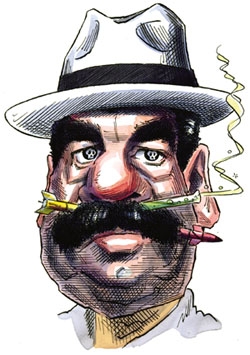- Military
- Security & Defense
- US Defense
- History

For the second time in just over a decade, the United States has mobilized military forces for war against Iraq. In both cases its adversary is Iraq’s Stalinist-style dictator, Saddam Hussein. In both cases the U.S. administration—headed in 1990–91 by George H. W. Bush and in 2003 by George W. Bush—lobbied with substantial success for formal congressional approval and authorization by the U.N. Security Council. In both cases it secured cooperation from Persian Gulf friends willing to serve as military and logistical bases for the operation, and from allies in and out of the region agreeing to provide combat support. And in both cases the overwhelming military superiority of the United States ensured success on the battlefield.
But the second Persian Gulf War, or PG II, is not simply an appendix to PG I. This time, the casus belli is less clear, the political goals both vaguer and more ambitious, the international standing of the United States vastly different, its vulnerabilities more evident, the oil issue changed in focus, the commitment more open-ended, and the measures of success more elusive. Nonetheless, the differences do not suggest that the administration has committed a strategic blunder by again confronting Iraq. Rather, they argue for the president and his team to articulate the stakes in PG II in ways that relate this struggle to a broader strategic design: a worldview to which citizens both of the United States and of other nations—including the Arab world—can relate.
Setting the Stage
In August 1990, Iraq committed an act of naked aggression against Kuwait, invading and seeking to absorb its oil-rich neighbor and, through intimidation if not further conquest, to effectively gain control over much of the area’s oil production, beginning with Saudi Arabia. The United States and the Soviet Union instantly condemned Iraq’s action, and the U.N. Security Council quickly followed suit, demanding an immediate Iraqi withdrawal. When Iraq remained resolute, the United States rushed troops to the area and the Security Council passed a resolution authorizing member states to employ all necessary means to compel compliance, a term universally interpreted as military force.
This time, the issues involve Iraq’s failure to abide by past Security Council resolutions requiring the disclosure of all programs involving nuclear, chemical, and biological weapons (and the missiles to deliver them) and submission to a substantially open-ended control regime involving highly intrusive inspections. After months of backstage negotiations, the Security Council passed Resolution 1441, which declared Iraq to be in “material breach” of past obligations, while demanding a new “currently accurate, full and complete” documentation of existing programs and again providing for comprehensive inspections on the ground. But 1441 was left intentionally ambiguous on how compliance was to be determined and under what circumstances, if any, member states were authorized to initiate military action.
Iraq’s initial effort to mollify the international community—submission of a 12,200-page document denying work on weapons of mass destruction (WMD)—was roundly condemned as inadequate. It was also flatly inconsistent with Western intelligence, which had acquired information regarding Iraq’s continued production of chemical and biological agents, development of mobile laboratories for such work, illegal retention of extended-range missiles, and efforts to purchase technology and materials potentially useful in the production of nuclear weapons. The United States and Britain provided U.N. inspectors with corroborative evidence of such activity, but absent a “smoking gun” the case against Iraq, in its initial stages, lacked the clarity of PG I, particularly among those groups already suspicious of U.S. motives. Informed observers predicted, however, that the war itself would produce conclusive evidence of WMD activity by Iraq, including the testimony of scientists and others involved with the work.
Nonetheless, with the proliferation of WMD programs now a fact of international life—underlined by the shocking declaration by North Korea that it was resuming its production of fissile material—waging war against Iraq alone suggested to many observers the presence of other controlling motives, rather than a necessary response to a real provocation. It has been widely noted, for example, that Iraq’s development and use of chemical weapons during the 1980s drew only the mildest rebuke from the Reagan and Bush administrations. Contrary to PG I, Iraq’s WMD work is now central to the legitimacy of moving against it.
Regime Change
Saddam Hussein is, of course, the designated villain of both campaigns. But removing him was expressly disavowed as a purpose of PG I by the Bush administration. At the time, of course, U.S. intelligence believed Saddam would not be able to retain power after his disastrous adventure in Kuwait. The administration believed that a toppled Saddam would be a positive outcome, but it would have welcomed regime change only in the context of a stable Iraq. Ideally this would have meant a coup against Saddam executed by his fellow generals—with no change in the Iraqi government as a counterbalance to Iran in the Persian Gulf and as the authoritarian force keeping the Kurds and Shiites in check. A shake-up that resulted in a new form of Iraqi government, or that set off political shock waves throughout the region—particularly inside neighboring Saudi Arabia—would have been extremely unwelcome.
In today’s conflict, the stated goal of regime change involves far more than the mere removal of Saddam Hussein. If, for example, a handful of Iraqi generals were to kill Saddam and seize power during the early stages of PG II, one can imagine the Bush administration confronted with several interesting questions: Should it simply declare victory and get out, leaving political dependents to their fate, as was the case with the Kurds and Shiites after PG I? What, beyond a continued WMD inspection regime, could the United States reasonably demand? Should it settle for a stable, authoritarian Iraq—the desired outcome of PG I—or should it try to cobble together an Iraqi federation with institutions designed to promote representative government, separation of powers, and a rule of law? Some members of the current Bush administration have long urged establishing an Iraq that could serve as a model for transforming the region by providing the Arab world with its first real democracy.
The developing notion of what constitutes desirable change in Iraq is largely a function of the events of September 11 and their impact on the U.S. view of the region. In the run-up to PG I, terrorism was a strategic afterthought. Now Islamic terrorism is a front-burner international issue. Such terrorist organizations as Hezballoh, Hamas, and Islamic Jihad still command broad support in the region, much of it from sovereign states. Further, the involvement of so many Saudi nationals in the September 11 attack, Saudi Arabia’s genteel treatment of Al Qaeda operatives, its “see no evil” approach to the financial support for international terrorism provided by many Saudi citizens, the militant Wahabi brand of Islam built into Saudi-financed schools the world over, and the structure of Saudi society itself have led to a rethinking in Washington about the meaning of stability in the Middle East. No longer is perpetuation of the Saudi regime in its current form a given of U.S. regional policy. Indeed, some suggest that, if the United States can develop Iraq as an alternative path to Arab political development while boosting Iraqi oil production through restoration of the industry’s infrastructure, Saudi political and economic leadership could be severely undermined, with the corresponding possibility that the Saudis might begin groping toward political reform. Some policymakers believe such a possibility could send a powerful message to Arab and other Islamic states.
The Big Bully
The current administration is playing to a tough international audience, far tougher than was the case at the time of PG I. In 1990 the United States was riding high in terms of international support. The United States was in the final stages of Cold War victory in Europe; it was still working closely with Pakistan in support of mujahideen fighters battling Soviet clients in Afghanistan; and the first Palestinian intifada had been greeted with sympathy in much of the United States, where Israeli occupation policies were under increasing fire. Further, the Bush team skillfully knit together a participatory coalition of Arab states against Iraq’s aggression in Kuwait.
The world of PG II is vastly different. Some of the closest U.S. allies discern in its global demeanor a heavy-handed bullying of friends coupled with a sudden penchant for unilateralism. The reaction in some Islamic communities to the events of September 11 has been one of satisfaction that the international “bully” was manifestly so vulnerable to Islamic martyrs. Intifada II has contributed to the polarization of political attitudes, with the Islamic world outraged by the Israeli crackdown, and many Americans equally incensed by Palestinian terrorism. In this context, much of the Muslim world sees the U.S. move against Iraq as unprovoked and arbitrary, the sort of thing that would never be contemplated against a non-Islamic state. To holders of this view, President Bush’s awkward early response to North Korea’s return to the game of nuclear blackmail was “exhibit A.” Rather than seeking to draw phantom moral distinctions between the two rogue states, the president might have fared better had he condemned North Korea’s action in strong terms, branded a nuclear North Korea “unacceptable,” but also explained that the presence of regional friends such as South Korea, Japan, Russia, and China, with interests similar to our own, provides the United States with economic and diplomatic options not present in Iraq. And there was no compelling reason for the president to gratuitously rule out the use of force.
There is, of course, compelling evidence to rebut this caricature of the United States, but those portraying the U.S. as hostile to Islam tend to dismiss Afghanistan, Bosnia, Kosovo, and Somalia—not to mention PG I itself—where the United States committed forces for the defense or protection of Islamic populations. Why? Because they see the world either through the prism of the Israeli-Palestinian dispute or through the eyes of a spreading and intensifying Islamic fundamentalism.
How important is the changed political environment? Possibly very important. The current coalition has fewer participants than PG I, and many of those who joined did so under heavy pressure from Washington. They may start to grouse or even withdraw their support if, in its early stages, the war goes badly. Some may face domestic dissent; others may become targets for anti-Western political movements and terrorists, just as the U.S. presence in Saudi Arabia during PG I—and its maintenance of bases thereafter—energized Osama bin Laden to target both the Saudi regime and the “big infidel.” Reaction of the “Arab street” may play the role in PG II that many pundits erroneously expected it to play in PG I.
Oil was perhaps the significant factor in PG I. The U.S. administration saw Iraq’s aggression against Kuwait—and the threat of a subsequent attack against Saudi Arabia—as a threat to vital U.S. interests. Once the Iraqis were expelled from Kuwait, vital U.S. interests were deemed satisfied. Oil is again a subject of discussion, but in PG II the subject is Iraqi oil, which is usually discussed as a residual benefit of the military operation rather than its central purpose. Some policymakers maintain that the United States can boost postwar Iraqi oil production, with the extra revenue helping compensate the United States for the costs of its military intervention and helping rebuild the shattered Iraqi economy. Additionally, many see an Iraq responsive to U.S. interests as capable of putting a huge dent in the ability of Saudi Arabia and its OPEC partners to dictate world production levels. But the billions it would cost to repair Iraq’s oil-producing infrastructure to the point where it could either defray U.S. military costs or undermine OPEC argues against so grandiose a scheme. And a substantial diversion of Iraqi oil revenues to Western pockets could play into the hands of extremist Islamic opponents who are already charging that such issues as WMD and opposition to international terrorism are mere pretexts for a U.S. grab of Iraqi assets. Oil, in sum, appears to be an issue in PG II only to the extent that its generated revenues have assisted Saddam Hussein in pursuing his WMD programs. Remove Saddam and oil appears tangential to the conflict.
Postwar Scenarios
When PG I ended, the withdrawal of the vast preponderance of U.S. forces became a logistic question rather than a political one. The first Bush administration sought to wash its hands of the political aftermath in Iraq, later intervening reluctantly to protect the Kurds. By contrast, the U.S. presence after PG II will be substantial. Should Iraq’s military forces themselves remove Saddam to maintain the status quo (minus WMD and hospitality for international terrorists), a Bush administration declaration that regime change has been achieved and the U.S. mission accomplished would be greeted with widespread skepticism. Much more appears to be at stake.
Iraq must be protected from foreign predators such as Iran that are anxious to shape the country’s political future. Domestic security must be stabilized to prevent one faction or another from taking advantage of a moment of general weakness. A framework for the establishment of representative government in an environment of human rights and political freedom must be established. The claims of both internal and external opponents of the current regime must be assessed—no small task, since 20 percent of the country’s population now lives in exile. Priorities for the economic revival of what was once a prosperous society must be established. The elements of a progressive educational system must be put in place. The ruling Ba’ath Party must be dismembered and its top leadership brought to justice. A military responsive to civilian control must be fashioned.
Some have likened the role to be played by the United States as similar to the one played in Germany and Japan following World War II. This may be overstating it but not by too much. Both those involvements were of rather short duration. Both saw important government tasks quickly turned over to the native population. Both witnessed rapid democratization and the development of free markets. Both saw a great deal of institution building. Both took advantage of resident expertise in areas such as business, economic policy making, education, and law enforcement. After PG II, there may be greater opportunities for the involvement of the United Nations, other members of the international community, and nongovernmental organizations, but the United States will be first among unequals; and predictions of a substantial presence lasting less than three to five years are probably unrealistic.
Measuring the success of PG I was rather straightforward. The “bad guys” invaded Kuwait. The “good guys” kicked them out. The resulting arms inspection and destruction regime, although ultimately flawed, set back Saddam’s WMD program by many years. The principal area for the supply of Western oil remained relatively secure. The accentuated involvement of the world’s only superpower in the region led to important, if still inconclusive, new rounds of talks between Israel and Syria on the one hand, and Israel and the Palestinians on the other.
Judging PG II will be more difficult. “Regime change” will likely be the first major result of the military campaign, and termination of Iraqi WMD programs, the second. Following that will likely be some symbolic gesture underlying the declared policy of the new regime that international terrorists will find no welcome at Iraq’s doorstep. So far so good. But unlike PG I, this should not permit the United States to declare “victory” and get out. If Iraq quickly becomes a hotbed for factional strife, if another military strongman rises quickly to power, if the administration fails to build on its momentum to again address the Israeli-Palestinian dispute, if foes of liberal democracy successfully portray the U.S. mission as one of acquisition and plunder, if the democracy imposed on Iraq proves transient and no other Arab country elects to follow it, and if the consequence of the mission is to encourage international terrorism rather than deter it, then toppling Saddam and ending his WMD programs may not be worth the cost. But there are signs that the Arab world may be more receptive to democratic reform than it has been in many years—and that the Bush administration is committed to the kind of effort that could make PG II a significant step toward such reform.
The marriage of undemocratic Arab governments with fanatical Islamic movements poses a clear and present danger to the United States and other Western societies. A truck bomb nearly toppled one of the World Trade Center towers in 1993; eight years later two hijacked commercial jets finished both towers. Eight years from now, the terrorist seeking to destroy U.S. society may strike with chemical, biological, or even nuclear weapons, while his mullahs issue fatwas exempting his conduct from the command against murder and his leaders release tapes celebrating the carnage. Together they take refuge in the notion that they are participants in a “clash of civilizations.” But as President Bush said when addressing the cadets at West Point in June 2002, “When it comes to the common rights and needs of men and women, there is no clash of civilizations. The requirements of freedom apply fully to Africa and Latin America and the entire Islamic world. The peoples of the Islamic nations want and deserve the same freedoms and opportunities as people in every nation. And their governments should listen to their hopes.”
In PG II the president’s words are being put to the test.
















